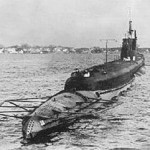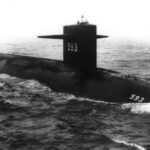 When Titanic vanished beneath the waves of the Northern Atlantic Ocean in the early hours of April 15, 1912, it would remain far below the depths for nearly 75 years, untouched and unseen. For decades, a lack of seafaring and ship salvage technology would keep Titanic hidden from sight. However, that all changed in the early 1980’s, when maritime archaeologist Robert Ballard began to develop technology that would allow him and his team to search the area where the great ship sank. When Ballard discovered the wreck of Titanic in 1985, the find shocked the world and rocked the maritime community; however, few knew the real reason for the expedition, or what lay at the heart of his mission.
When Titanic vanished beneath the waves of the Northern Atlantic Ocean in the early hours of April 15, 1912, it would remain far below the depths for nearly 75 years, untouched and unseen. For decades, a lack of seafaring and ship salvage technology would keep Titanic hidden from sight. However, that all changed in the early 1980’s, when maritime archaeologist Robert Ballard began to develop technology that would allow him and his team to search the area where the great ship sank. When Ballard discovered the wreck of Titanic in 1985, the find shocked the world and rocked the maritime community; however, few knew the real reason for the expedition, or what lay at the heart of his mission.
1. The Mission’s Early Days
In the early 1980s, Ballard was working for a non-profit organization called the Woods Hole Oceanographic Institution. Founded in 1930, the Massachusetts-based institute focuses on ocean-based research and operates on grants and other funding provided by private groups and contracts granted by certain large industries. Back in the 80s, Ballard was working on a series of robotic systems there that could scan and collect data as it swept the ocean floor. These systems would be unmanned and controlled from a remote location, as the depths to which Titanic sank could not be reached by divers. Eventually, Ballard would create a robot camera called the Argo and approached the U.S. Navy for funding in 1982. He was turned down, but the military organization had other plans for Ballard and his new technology.
2. An Undercover Mission
 Although Ballard could not get funding for his Titanic mission, the Navy had a counter offer in mind for the oceanic scientist: they would supply him with funding and a chance to search for the sunken ocean liner, if he could locate two lost nuclear submarines that had gone missing in the 1960s. These submarines, the USS Scorpion and the USS Thresher, were both lost at sea, along with their entire crews. 228 men died in total, and the causes for both sinkings were largely unknown. The Navy funded a search for the remains of the submarines and would allow Ballard to continue his search for Titanic: if he completed his main mission first.
Although Ballard could not get funding for his Titanic mission, the Navy had a counter offer in mind for the oceanic scientist: they would supply him with funding and a chance to search for the sunken ocean liner, if he could locate two lost nuclear submarines that had gone missing in the 1960s. These submarines, the USS Scorpion and the USS Thresher, were both lost at sea, along with their entire crews. 228 men died in total, and the causes for both sinkings were largely unknown. The Navy funded a search for the remains of the submarines and would allow Ballard to continue his search for Titanic: if he completed his main mission first.
3. The Classified Mission Begins
When Ballard began his search, few people involved with the project knew he had been made a temporary acting naval officer and the real reason for the search. Others on board were all civilian and assumed Ballard had managed to secure his funding. Only Ballard and a few others knew that the search for Titanic was a cover to locate and inspect the two nuclear submarines and determine why they sank, if possible.
The details of what had happened to the USS Thresher had been discovered in the months and years subsequent to its sinking, and it had been ruled that mechanical failure had caused the tragedy. However, the fate of the USS Scorpion, which vanished in 1968, was more of a mystery. Many Naval officials were suspicious that the submarine had been attacked by a Russian vessel during the cold war and wanted Ballard to confirm this, if possible. Debris from both vessels were discovered during this first dive, and Ballard and his men took some on board their ship, undercover, and stored it in a sealed room on board their larger ship for inspection. While the fate of the Scorpion is still largely unknown, Ballard did conclude that it was unlikely the submarine took any artillery fire. Eventually, the Navy ruled that Scorpion must have suffered some unknown mechanical malfunction, causing it to implode.
4. A Second Secret Mission
 A year after Ballard’s team recovered debris from the USS Scorpion and discovered the wreck of Titanic, he announced a second dive that would attempt a look inside the great ocean liner and to photograph its main staircase. However, this story was simply a cover for another Naval mission, which was to discover whether the sinking of either submarine had released nuclear waste into the water upon their implosion. While Ballard did indeed return to Titanic during this mission, his findings regarding possible nuclear fallout remain classified.
A year after Ballard’s team recovered debris from the USS Scorpion and discovered the wreck of Titanic, he announced a second dive that would attempt a look inside the great ocean liner and to photograph its main staircase. However, this story was simply a cover for another Naval mission, which was to discover whether the sinking of either submarine had released nuclear waste into the water upon their implosion. While Ballard did indeed return to Titanic during this mission, his findings regarding possible nuclear fallout remain classified.
The discovery of Titanic was a thrilling moment for anyone who held an interest in the world’s most famous lost ocean liner. However, the facts of her discovery have remained shrouded in mystery until now. Despite the secrecy and the mystery of the lost submarines, Titanic continues to hold sway over the imagination of millions all over the world.

